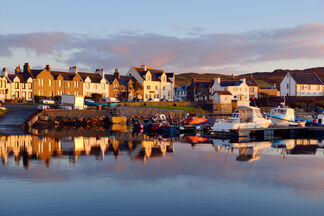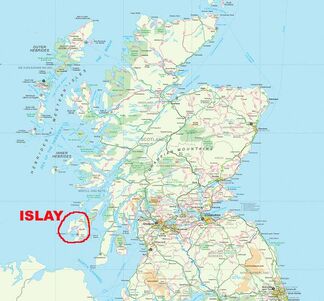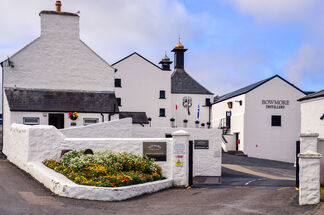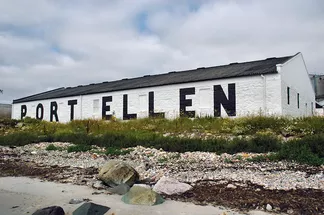The Islay Whisky: Region Part 1
About Islay
Islay is one of the six Whisky regions in Scotland alongside the Highlands, Lowlands, Speyside, Islands and Campbeltown regions. Islay is probably best known for producing extremely peaty whisky although there are some rather fine smooth whiskies coming from Islay too. Its another North - South divide!
Like all Scottish Islands, Islay is full of natural beauty and has a deep history. Islay is an incredible region and contains way too much for a single blog entry. I could easily get carried away here and write more than you will read. So I am breaking down Islay into a series of 3 entries. This first one will give you an introduction and an overview of Islay and it’s whiskies plus an insight into its history of whisky and some recent developments taking place. The second will cover the 9 currently working distilleries and their whiskies. And the third will take a look at the lost distilleries of Islay and the traces they have left behind.
Where is Islay?
How do you pronounce Islay?
Islay is an Island that lies at the entrance to the Firth of Lorn to the west side of the Kintyre peninsula, roughly 25 miles north of Northern Ireland. It is one of the six Whisky regions of Scotland, with 9 active distilleries and 2 more in the process of being built.
But one of the biggest mysteries to non-native Scots is …. How do you pronounce Islay??? Well, forget the “S” and say it like Eye-la and you won’t be far wrong.
The Isle of Jura, the Kintyre peninsula (home to Campbeltown) and Northern Ireland are neighbours. The island is 40 km wide by 25 km long; with a heavily-indented coastline and the deep bays of Loch Gruinart and Loch Indaal, the land area amounts about 600 km2. These bays, arranged back to back, almost divide the island in two.
At the last census of 2011 Islay had 3,228 inhabitants in 1,479 households spread over 62,017 hectares. On average, 45,000 summer visitors arrive each year by ferry and a further 11,000 by air. The island's capital is Bowmore and is home to almost 1,000 inhabitants. Other major villages are Port Ellen, Port Charlotte and Portnahaven.
The world's first commercial wave-powered electrical generation station was built in 2000 near Portnahaven on Islay, and Lord George Robertson, former NATO Secretary General, was born in Port Ellen.
The Whiskies of Islay
Heavily Peated?
There are currently nine working distilleries on Islay. Ardbeg, Ardnahoe, Bowmore, Bruichladdich, Bunnahabhain, Caol Ila, Kilchoman, Lagavulin and Laphroaig. I will take a deeper look at each of these in the second part of this Blog entry. And at one time there were as many as 23 distilleries in operation on Islay.
The first recorded distillery was Bowmore, founded in 1779; and the most recent was Ardnahoe, which was established in 2018. Islay’s distilleries are spread across the island; however, the three on the south coast – Ardbeg, Lagavulin and Laphroaig – are located next to each other, and are collectively known as the Kildalton Distilleries. These three are renowned for making whisky which is "medium-bodied ... saturated with peat-smoke, brine and iodine" because they use malt that is heavy with peat as well as peaty water. Whisky from the northern area is milder because it is made using spring water for a "lighter flavoured, mossy (rather than peaty), with some seaweed, some nuts..." characteristic. So Islay whisky is not all heavily peated. The further North of the Island you go, the milder it is - but that just means less peat than in the South!
Irish monks are believed to have begun distillation on Islay during the early fourteenth century. But there are no records or hard evidence of that. The island is perfect for whisky production, with unlimited supplies of peat, as well as lochs and rivers filled with pure soft water. Local crofters grew an early form of barley (bere) for food and distilled what did not get eaten.
Distilling was originally carried out openly until a tax was levied on whisky in 1644 as part of the Excise Act. This forced the distillers to move into remote glens and caves to avoid detection. There was, however, great reluctance on the part of the exciseman to come to an island where the natives were regarded as a “wild barbarous people”. In 1777, the Reverend John McLeish of Kilchoman Parish reported that, “We have not an excise officer on the whole island. The quantity therefore, of Islay whisky made here is very great and the evil that follows drinking to excess of this liquor, is very visible on the island”.
The Mull of Oa peninsula was well known for illicit distilling, with stills found at Cragabus, Stremnishmore, Lower Killeyan and Goil.
As much as 95% of the whisky produced on Islay was used in the make-up of all the famous blends (Johnny Walker, White Horse, The Famous Grouse, Bell’s and countless others). However, a far greater proportion of whisky is now “laid down” with the increasing global interest in Single Malts. Stock shortages of mature whisky for this market have made some of the current bottlings very collectable. In 2021, five bottles (The Bowmore Archive Cabinet) sold at auction for £409,000.
The Story of Port Ellen
A New Lease of Life
Port Ellen was established as a malt mill in 1825, and then developed as a distillery between 1833 to 1892. The warehouses built then still exist and are listed buildings. The distillery was acquired by the Distillers Company Limited in 1925, was closed in 1930 and rebuilt in 1966/1967. It continued in production throughout the 1970s and was closed in 1983 under Diageo ownership. At that time, some of the buildings were knocked down and others repurposed. The stills were destroyed. The distillery housed a malting which continues to supply Islay distilleries, per an agreement signed in 1987.
Some bottles of Port Ellen whisky produced pre-1983 are still available and are collectors items. Bottles of older Port Ellen will cost you between €1200 and €2500 and probably a lot more!
On 9 October 2017, Diageo invested £35 million to re-open Port Ellen and Brora (a Highlands distillery also owned and closed by Diageo in 1983). On 8 May 2019, Diageo submitted plans to revive the distillery, and to build a new stillhouse. Diageo say they are going to considerable efforts to recreate as similar as possible new stills, based on records from the 1980s. And they have former Port Ellen employees working for them elsewhere on Islay to assist in an accurate recreation of the Port Ellen style. The Distillery build is currently under the management of Alexander McDonald, an Islay resident with previous positions held in Kilchoman, Lagavulin and Caol Ila distillery. As of 2022 plans are for the distillery to reopen in 2023.



